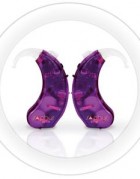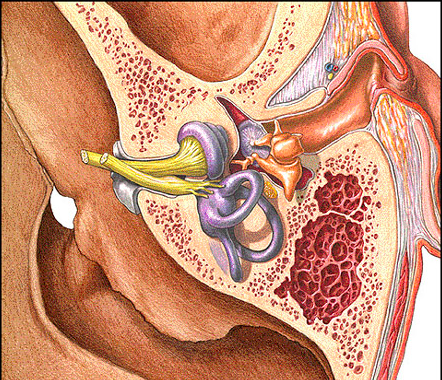Cochlear implants can be seen as controversial. In many cases this controversy is fuelled by a number of myths. This page collects up these myths and corrects them.
Myth 1: The surgery to place a cochlear implant is brain surgery.
This is incorrect. A cochlear implant is inserted into the cochlea. The cochlea is a spiral shaped structure in the boney labyrinth. This is the structure (light purple) shown in this picture:
The cochlear implant electrode array stimulates the nerve fibres (shown in yellow) which transmit electrical signals to the brain.
There is significant bone structure between this boney labyrinth and the cranial cavity that holds the brain. The surgeon and the electrode array do not enter the cranial cavity.
Myth 2: Cochlear implants cause deaths.
Cochlear implants have not caused any deaths according to the FDA.
There have been a very small number of deaths caused by secondary issues. Meningitis is the principal issue and this is now mitigated against by pre and post implantation vaccination. Other deaths have been from pre-existing issues exacerbated by the surgery.
As with any surgery there are risks. However the success rate for cochlear implants is spectacularly high.
Cochlear implantation has become a safe procedure-and, as result of refinements in devices and surgical techniques, complications are atypical. – ENT Today August 2007
Myth 3: A cochlear implant will destroy any residual hearing.
A cochlear implant may destroy some or all residual hearing. However more recent implant surgical techniques and newer implant designs have significantly improved the retention of residual hearing. Many recent implantees now experience little or no loss of residual hearing.
It should be noted however that the retention of residual hearing is not necessarily a positive. For children with auditory neuropathy, it may be preferable for only the cochlear implant to provide auditory stimulation.
In addition, many implantees have no useable hearing to retain.
Myth 4: A cochlear implant candidate will require multiple CT and MRI scans.
CT or MRI scans are used to ensure that a potential cochlear implant candidate has suitable anatomy for an implant. In a very small number of cases candidates have malformed cochlea or no auditory nerve fibres. These cases present potential for cochlear implants not to be appropriate.
Different cochlear implant programmes have different protocols making this assessment. Typically a single MRI session would be all that is required. Some programmes specify a CT scan because these are more readily available/cheaper. A CT scan does not show as much detail. If something is spotted in a CT scan that is abnormal, an MRI maybe required.
As MRIs become more readily available, most programmes now simply have a single MRI as their protocol.
Myth 5: There is no problem with waiting until a child can make up their own mind whether to get cochlear implants or not.
Neural pathways are being formed in a child even before birth. And this is the case with the auditory side of brain development. Traditionally research has pointed to a 7 year window for the laying down of these neural path ways. More recent research is suggesting that the key foundations of auditory development occurs much earlier and it is very hard to change these pathways after a short period of time.
What this points to is for a child to develop their auditory abilities, this development must start as early as possible, preferably before the age of 2yo. Starting later will likely compromise the child’s ability to develop normal levels of hearing and spoken language. Waiting until a child can comprehend the decision to get cochlear implants will almost certainly cause that child to not be able to develop normal hearing and spoken language. In short, not making a decision is making a decision for the child to have sub-normal hearing and spoken language.
Myth 6: Cochlear implant hearing isn’t like normal hearing
Adult users who have had normal hearing and who have lost it report that cochlear implant hearing is more mechanical and high pitched. Simulations of what cochlear implant hearing is like are sometimes quite disturbing and indicate that such hearing is quite limited. However adult users also report that after a short period of time cochlear implant hearing sounds very normal.
In children who have been implanted early and bilaterally, speech production can be just like normal hearing children. This indicates that what they are perceiving must be very close to what normal hearing provides.
Myth 7: Once you get a cochlear implant, if a better implant or therapy is developed you will not be able to make use of it
This may or may not be true depending on the design of a new implant or the approach of a new therapy. What can be said with certainty however, is that if an ear is left unstimulated, the auditory nerve will atrophy and it won’t matter how good the device or therapy is, the ear won’t hear. This is very much a case of ‘use it or lose it’.
Myth 8: Doctors who perform Cochlear Implant surgery are only in it for the money
The cochlear implant surgery is a relatively common procedure for ENT surgeons. It is no more or less expensive than other surgery carried out by these surgeons.
Myth 9: People with cochlear implants can’t go swimming
Three of the major cochlear implant manufacturers actively advertise their products as swimmable. The Advanced Bionics Neptune processor is IP68 rated. Their Naida CI has a swimming accessory which again provides IP68 protection. The Cochlear brand speech processors have two systems that provides an IP68 rating. The MED-EL RONDO has a Waterwear accessory which is IP68 rated.
It is recommended however that cochlear implant users do not do deep diving because of the pressure exerted on the devices. Most manufacturers of swimmable implants rate the implants to 30m and the speech processors to around 3m (10 feet).
Myth 10: Cochlear implants have wires coming out of the skin
The cochlear implant consists of two components – an internal implant and an external speech processor. Signal and power is transferred between the two via matching induction coils – one inside the head and one outside the head. There is no physical connection between the two devices. Its all wireless.
Some prototype cochlear implants did have a physical connection. There are a handful of these still in operation.
Myth 11: Cochlear implants weaken the skull making it dangerous for users to engage in physical sport
While some surgeons create a recess for the implant body to sit in, this makes a negligible impact on the strength of the skull.
Cochlear implant users do however need to take precautions to ensure both the speech processor and the internal implant are protected. This would involve wearing suitable protection when engaged in sporting activities.
Myth 12: Cochlear implants are disfiguring
Cochlear implants are very discrete. In most cases it is difficult to identify people who are using them.
The surgical scar typically runs the crease line of the ear. More modern surgical techniques mean this scar line has shrunk to 1-2 inches.
More modern implants are now thinner and produce a minimal bump. Many surgeons create a recess in the bone to ‘house’ the implant meaning the bump is reduced further.
Myth 13: The hearing of cochlear implant users don’t get affected by ear infections and colds
Many cochlear implant users report that their hearing is affected when they have a head cold or ear infection. While technically this shouldn’t happen, it does seem to occur.
Myth 14: People with cochlear implants can only hear environmental sounds and can not understand speech without reading lips
Children who are implanted early typically develop hearing, speech and language equivalent to their hearing peers (particularly with bilateral implantation) without the need for lipreading.
Older children and adults who loss their hearing after they have developed their hearing, speech and language typically are able to hear and speak as they did before – particularly with bilateral implantation.
Many cochlear implant users who have relied on lip reading prior to implantation report that they rely less or become significantly less proficient at lip reading once they use a cochlear implant. Simply, they can hear and understand speech.
Myth 15: When a person gets cochlear implants they are immediately able to hear
For people who have heard previously and have quickly and recently lost their hearing, it is quite possible for them to be hearing again within minutes of having their cochlear implants turned on. However even for these people, they will find their hearing quality improves over time with adjustment of the speech processor programmes and with experience using the device.
For pre lingual children, the brain has to learn to hear. This can be a multi-year process of learning to hear and catching up with their hearing peers.
Most cochlear implant users fall somewhere between these two extremes and require some time and effort to learn to hear through their cochlear implants.
As a rule of thumb however, it is likely that a cochlear implant user will leave their switch on session hearing more than what they heard prior to having their surgery.
Myth 16: Cochlear implants will work for anyone with hearing loss
A cochlear implant will work for anyone who has the appropriate anatomy to support it. This includes an active auditory nerve, an appropriately formed cochlea and either formed auditory pathways or the ability to form these pathways. However a cochlear implant is not necessarily the appropriate intervention. If a hearing loss is conductive, a bone conduction device would be more appropriate. If the hearing loss is mild to severe, a hearing aid may be more appropriate.
For people without the appropriate anatomy to support a cochlear implant, an Auditory Brainstem Implant (ABI) may be an option. This option does involve brain surgery.
Myth 17: Cochlear implant placement involves major surgery
The implant surgery is often a “same day surgery” that does not require an overnight stay. ENT surgeons regard it as an established and routine operation.
Myth 18: I’m “too old” to get a CI
If you are less than 102 years old, there are older people than you who have got cochlear implants.
Myth 19: Cochlear implants are easily damaged, need replacement, or stop working.
Device failures or complications are extremely rare. Most manufacturers have failure rates of less than 2% after 7 years. The implants are designed to last a lifetime. However with only around 30 years of history behind them it is still to be seen if a modern implant will last 70-80 years.
Myth 20: A cochlear implant becomes outdated and will need to be replaced often.
A cochlear implant is made up of two components – an implant and an external speech processor. The implant is designed to last a lifetime and will not need updating. The external speech processor is designed to last between 5-10 years. Over an average lifetime that might be 7-10 external processors. Compared to the number of pairs of glasses a person might go through in the same space of time, that is relatively infrequent.
Myth 21: Cochlear implant users cannot have X-Rays, CT scans, or MRIs.
Cochlear implant users can have X-Rays and CT scans like anyone else. MRI scans up to 1.5T can be done with compression bandages on all modern implants. Some implants can have scans up to 3T.
Myth 22: You must turn your cochlear implant off when flying
There is no need to turn your cochlear implant off when flying, even though it is a transmitting device. The range of the transmission is very limited.
Myth 23: You must turn your cochlear implant off when you go through airport security scans
There is no need to turn your speech processor off when going through any airport security scan. Such scans will not damage the cochlear implant. Such scans may cause a small clicking sound if the tele coil is on. If the tele coil is off, there will be no noticeable impact.
In most cases the airport security scan will not even detect the implants and speech processors.
Myth 24: Cochlear implant users must avoid plastic slides and other play equipment that can generate static electricity
In the past cochlear implants have been susceptible to temporary damage from static electricity. It was possible for the programme in the processor to be damaged resulting in the speech processor needing to be reprogrammed. More recent processors contain protection circuitry to avoid this. While it is wise to avoid situations where there is the risk of large electrical discharges, unless it is a particularly bad ‘static day’ slides can be used safely.
Other electrical sources such as electric fences and household wiring should be treated with extreme caution as these do have the ability to permanently damage the internal implant.
Myth 25: You can not use a cochlear implant in a shower
A number of modern speech processors are splash and shower resistant. These are able to be used in the shower.
Myth 26: Cochlear implant users must stay away from wifi devices, cell phone towers and high voltage lines
Wifi devices will not interfere with the function of cochlear implants. In fact some modern cochlear implant processor uses a form of wifi to communicate with other devices.
Cell phone towers and high voltage power lines may affect the function of a cochlear implant, especially if the tele coil function is turned on. However the safe distances from such infrastructure is similar to a normal hearing person.
Myth 27: Cochlear implants are affected by microwave ovens
Just like with other devices that produce a radio signal, it is possible for a cochlear implant’s function to be affected, particularly if the tele coil is active. However there is no risk to the user or the cochlear implant.
It is recommended for cochlear implant users to be cautious around induction stoves and read the BCIG safety guidelines before using.
Myth 28: If you have cochlear implants you can’t be resuscitated with defibrillators
There are certainly risks for users of cochlear implants being resuscitated with a defibrillator. However the defibrillator devices are designed to pass current from one paddle via the heart to the other paddle. Therefore the current should not pass through the head. Cochlear implant users have been defibrillated with no damage to their implants.
Myth 29: You can’t play active sports if you have cochlear implants
Many users play active sports. While it is important to protect the cochlear implants with suitable headgear, there is no reason not to take part in active sport. There is also no need to remove the speech processors.
Myth 30: If you have cochlear implants you can’t go on roller coasters
Cochlear implant users can go on roller coasters. It is important however to secure the speech processor units so that they will not fall off
Myth 31: Cochlear implant users can’t hear or appreciate music
Research certainly shows that cochlear implant users on average have significantly poorer pitch perception than normal hearing people. However many cochlear implant users enjoy listening to music. Many play musically instruments. One news report showed a young lady with bilateral cochlear implants who has perfect pitch perception.
Myth 32: If you have a cochlear implant you can never wash your hair again
This is incorrect. When the speech processor is removed there is no reason why a user can not wash their hair. In fact, with modern water proof speech processors, users could wash their hair while still hearing.
Myth 33: If you get cochlear implants you can’t lipread or use visual communication
Many cochlear implant users continue to use lipreading and visual languages. While there is debate around the optimal approach to developing language skills for cochlear implant users, particularly pre lingual children, there is no physical reason why all forms of communication can’t be used.
Myth 34: If you get cochlear implants when you are young, you will have to get them replaced with bigger ones as your head grows
The cochlea is one part of the body that does not change in size. Provided the implant continues to function, the device should never need to be replaced.
Myth 35: When you get cochlear implants the surgeons will need to shave all of your hair off
Surgeons vary in the amount of hair that is removed. However many surgeons now do not shave any hair off at all. Others remove a very discrete amount behind the ear.
For a very small number implantees who have abnormal cochlea or require other surgical procedures, a greater amount of hair might be shaved off to allow a larger incision.
Myth 36: If you get cochlear implants your face will be paralysed
The surgery to insert the electrode array for a cochlear implant involves passing the array very close to a main facial nerve. In the past this has meant a number of early cochlear implant users did suffer temporary facial paralysis.
Current surgical practice tends to use a monitoring device and different surgical techniques to ensure the surgeon stays well clear of this facial nerve. In a recent large scale audit in the UK, only 0.2% of recipients experienced any facial weakness. There was no permanent facial paralysis.
If you would like to replicate this page on another site you are more than welcome. We do ask that you email this site and provide a link to where this material is being used. We would like to add any additional myths that you might have on your site.



